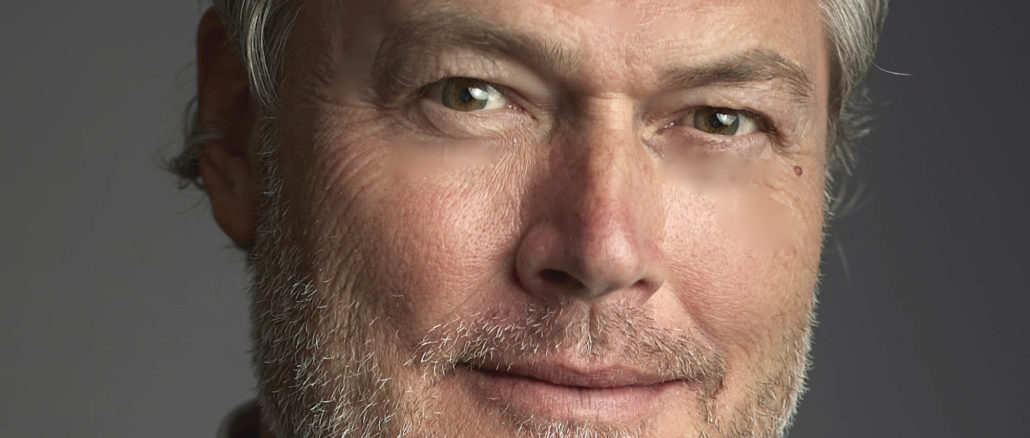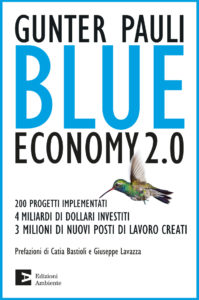
At COP21, consensus was sought before even starting. As a result, everything was watered down. But we can no longer wait: we have to buckle down to business, going beyond global agreements. We have to act at local level and in cities, working towards different business models and promoting the development of local areas.
Gunter Pauli, an entrepreneur, economist, ecologist, Blue economy inventor and one of the promoters of the Kyoto Protocol, is very critical of COP21 in Paris: he has solutions devised over a period of twenty years with his own ZERI Foundation (Zero Emissions Research Initiative) that go beyond the international agreements on climate, aiming at solving both social and environmental problems. We met him in Milan a few days after the end of COP21 in Paris.
COP21 closed in Paris a few days ago. What is your opinion on the agreement?
“I decided not to attend COP21. For two reasons. First, I am convinced that both the US Upper and Lower Houses will not ratify the agreement reached by Obama, while the second reason is that I took part in the organization of COP3 – where the Kyoto Protocol was decided upon – and I remember that we all knew that in the original version of the agreement there was a very strong group of States, such as Europe and Japan, that really intended to move forward with climate protection. In COP21, consensus was sought before even starting, so everything was watered down. When I saw the preliminary documents I realized that COP21 could only be a summit to meet interesting people, but nothing more. The first occasion to monitor any progress will be in four years’ time, but we cannot afford to wait that long. In essence, the COP21 in Paris was a summit that proclaims the end of global climate change negotiations. It is the end of the process started in Rio in 1992, and it is a good closure, because now we can start doing business in earnest.”
Doing business in earnest, how?
“We have to act in a tangible way at local level, in cities, with citizens and communities. We should not wait, but aim higher, unlike the international agreements that have failed. We have over 50 international agreements on environmental protection and the environment has never been as sick as today. We should not waste any more time with the global agreement model; we have to act now. I believe that one of the best things occurred during COP21 was the invitation by Anne Hidalgo – mayor of Paris – to thousands of other mayors throughout the world to discuss the best course of action about climate change. They can do a lot more than any national government because mayors decide how to act in cities.”
What instruments can we use to start a grassroots process?
“The most important change is about the business model. If we carry on with globalization, increasing international trade on a global scale, climate change emissions will also increase. We have to work with local economies, grabbing local opportunities: if we do not change the business model, we will not tackle climate change and will not meet citizens’ needs at local level. Using goods coming from the other side of the world instead of producing them nearer to us makes no sense at all.”
You reckon that fighting climate change, without clear direction, can have catastrophic effects. Why is that and what instruments have we got now, after COP21?
“One of the challenges we are faced with is that the Paris agreement has no instruments to be used, it contains no obligations to be fulfilled. Nothing. So, at the moment we have no instrument to force anyone in the direction of climate protection. We expect people to go ‘green,’ but will we have to wait at least 25 years before they actually do so? And what happens in the meantime? The only way to push people to act now is, as I have already mentioned, to plan and implement business models dramatically different to the current ones.”
For example?
“Let’s consider the photovoltaic sector. Everyone knows that ultimately solar power will be cheaper than fossil power, but the price drop is too slow and we need to speed it up. It is a process that needs another kind of approach, different to those taught in business administration master’s degrees, where attention is focussed on one thing at a time, such as CO2, water, electricity and cars. If we deal with only one aspect of production, it is impossible to come out of the pollution and climate change ‘trap.’ We have to work in the same way as nature does. We have to turn all business models in ecosystems, which are much more efficient than we might think. Actually they are much more so than any other systems designed by engineers or managers. I believe that the main issue is changing business model.”
But how can we do that?
“First of all we have to meet local needs with local solutions, wherever possible. It is necessary to create economic development not from exports, but by acting on local needs. In the USA, for instance, 25% of children are born into poverty. It is not acceptable that in the richest country on earth, one quarter of the newborn is poor right from the start of their existence. Today we can see clearly the limits of resources and how we are multiplying the effects on local economies. Importing salmon from Chile, apples from South Africa or computers from China, in the name of economic interests, means impoverishing whole areas, whilst we should put confidence in poorer people, by developing such areas. Nature has been doing that from time immemorial. Ecosystems fulfil local needs with local resources. We have to learn to live within certain limits, which does not mean going back to the Middle Ages or the Stone Age and living in poverty.”
That’s good, but in reality are there any practicable solutions today?
“Yes, there are. Let’s consider, as an example, a cup of coffee, which is a product marketed at global level, like many others. When we drink a coffee, we only consume 0.2% and the residue – 99.8% of the product – should not be thrown away because it is a resource. Spent coffee grounds can be used as fertilizer for mushroom farming and the waste of this production can become, in turn, protein for chicken farming. In this way we have three products instead of just one, and since the world production of coffee is ten million tonnes, we will obtain three times as many products. But, in order to do so, coffee must not be sealed in aluminium capsules, as it is now happening in the global trade, but put in thistle-based bioplastics, which can be produced locally and make possible reusing coffee. In this way, local economy is promoted, generating an income for local people. Today, instead, we embraced the opposite way of thinking, externalizing all environmental costs and using international trade only.”
So is Europe in the wrong when it believes that in order to get out of this crisis it should export more?
“Germany, for example, depends on exports and for this very reason is ranking amongst the world’s ten countries for employment levels. But in other countries, no employment is generated and poverty goes up: this is a trap because in this way employment only grows in ten countries and migration increases. This happens in Italy as well, where peripheral areas, such as the islands have lost inhabitants for 25 years, because people do not see any future there. It is necessary to find a balance between trade and local needs. Italy is an interesting case in point because it is one of the very few States that has actively moved in the direction of the bioeconomy. One of the things we should do is reconnecting agriculture with the industry. Today we regard agriculture as the past, thinking that it does not generate economic development. Far from the truth. Suffice it to look at the food production sectors and those for the production of machineries for such uses. We need to integrate the primary sector with the secondary one, by producing value in our economies. We need to remind ourselves that growth is not made of absolute numbers. Today we are no longer aware of the increase of the overall value because globalization and international trade push us to think about cutting costs only. For this very reason, most Italian businesses produce overseas and not at home and this is why we should find this new balance. The question is: how many advantages from agriculture, fishing and mining can benefit the production of goods at local level?”
A new balance for new advantages. But on what scale, given that the global one has some limitations?
“The national level does not work either. We need to work on the regional model and identity like the European Union did. I believe that when we invest in the regional identity, the local economy can grow stronger, as opposed to investing in a globalized economy. Although there are some contradictions, think of water for example. We invested billions of euros in local infrastructure for water resources, but we buy water in plastic bottles, made with oil and marketed by international brands at a price fifty times more expensive. Developing such economies does not make sense. The experience we carried out with ZERI foundation in several areas of the world showed us that a different economy not only is possible, but it is also the only way to reach full employment. Today people are surprised when they hear the phrase ‘full employment’ and most politicians say that it is impossible, but if people think that from the very start, obviously their target will never be achieved and percentages such as 10, 15 or 20 of unemployment will be regarded as acceptable. Today, in Spain for example, where they believed that thanks to the global economy they could halve unemployment, 25% of young people have never had a job in their life. What kind of society is created when priority is given to global competitiveness and international trade? When people tell me that they own nothing therefore they can do nothing I reply: ‘Look again’.”
We are used to high energy intensity. How can we even think of carrying on having enough wellbeing with lower energy intensity?
“High energy intensity is taken for granted, so it becomes a need. An example. Industries need energy to produce compressed air, but the most efficient air pump on Earth is the whale which is able to compress hundreds of litres of air with 6 volts of electricity, without maintenance, for 80 years. What engineer can today reach a whale’s efficiency? This is what we should realize. We think in an inefficient manner and we are far away from other species’ way of thinking. Pumping air in the same way as whales do could save us 90% of energy used in the process. This is no small thing, given that air compression represents 10% of industrial consumption. So we can go from 10 to 1% just by learning from whales, thus saving costs and energy. We think we are efficient only when we do not compare our efficiency standard with those of nature. I am convinced we created the need of high energy intensity because we accepted inefficient energy planning as normal.”
It is all very well for whales and industrial processes. But what about day-to-day life?
“Our homes have huge potential. 80% of everything we use in our homes today is fuelled by DC, but we use 220 V AC. This is because we want to centralize the production of electricity, transmitting it to long distances, but this is highly inefficient. Let’s consider, for example, the case of PV-powered LEDs. PV power generates DC that is converted into AC and reconverted in DC to power LEDs. A double conversion means double waste. We have not got small DC networks in our homes so we lose 20%-30% of electricity in conversions. This does not make sense when there are solar panels on the roof.”
How can we divulge these ideas, this vision, in order to convince businesses to use them?
“We need to involve market leaders. In Holland, for example, the second electricity distribution company, Eneco, decided to promote the supply of DC to new city areas. Cities are interested in using their own electricity in the best possible way. They are not interested in transporting great amounts for long distances. Cities are concerned about obtaining electricity at the lowest cost, in a stable manner and if possible from renewable sources. Even the large home appliance companies are increasingly interested in DC and have specialized engineers in DC studying how to use it, giving up AC. Then it is necessary to develop demand from consumers to promote such transition. Cities, for example, can promote the use of LED systems without inverters or transformers, rapidly imposing these new standards to increase efficiency. But a connection is still missing: most engineering students do not learn anything about DC and its advantages. If we do not educate and stimulate minds in this direction, the next generation of creative minds will lose this and other challenges.”
By way of conclusion, you have six children: is there something we can do, besides what you already told us, for the next generations?
“I believe that as a father my greatest responsibility is not to teach things to my children but that of inspiring them. We have to inspire children with ideas that they cannot see on TV today, ideas that are not advertised. We have become expert in spreading information, even to our children, only bad news, such as that of the extinction of many species, the destruction of whole forests, economies and jobs. The urgency for the next generation is to tell them about the incredible things that are possible and that our generation did not do. Every day, we have to devote three minutes to inspire children, to tell them stories, to share. I believe that this world can go on in the right direction if we put international politicians, bankers, stock traders behind us. We have to start to inspire our children.”
The book of Gunter Pauli Blue Economy 2.0 (italian edition)
www.edizioniambiente.it/libri/1091/blue-economy-2-0/
This article was published on Renewable Matter

